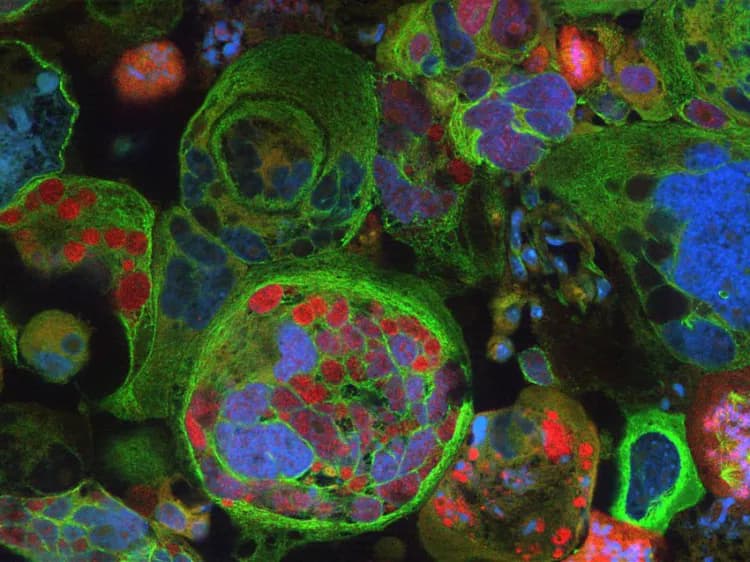Glioblastomas are incurable malignant brain tumors. Usually the patients affected survive for only a few months. In addition, every tumor is quite different, which makes treatment very difficult. Researchers at the University of Bonn have now developed a completely new method as the basis for creating custom-tailored, two-stage therapies. Using tumor samples from a patient, they do lab tests to determine which substances can first make the different types of cancer cells uniform and then effectively kill them. The study has already been published online and will soon appear in the print edition of the technical journal Clinical Cancer Research.
Glioblastomas are among the most common and malignant of brain tumors. "The tumor cells characteristically display great variety," says Professor Dr. Björn Scheffler of the Institute of Reconstructive Neurobiology at the University of Bonn, who recently began doing research at the German Cancer Research Center in Heidelberg and is a Professor at the Essen University Hospital. The cells in such a brain tumor can display very different characteristics, such as varying cell size or number of cell nuclei. Because the different cancer cells within a tumorous tissue also develop different modes of defense against therapeutic measures, the treatment of patients is extraordinarily difficult. After surgical removal, radiation, and chemotherapy, this type of tumor often returns; drugs are then usually no longer effective.
A team under Professor Scheffler, consisting of researchers from the Bonn University Hospital, the Life & Brain Center, The German Consortium for Translational Cancer Research, Tufts University Boston/Massachusetts, and other institutes in the USA, has now developed a new method that is expected to combat such complex brain tumors better. From tissue and cell samples from five glioblastoma patients, the scientists obtained 33 individual cancer cells capable of reproduction, which grew into very different tumors in the lab. For each patient, multiple representative test systems were thus available to study the different facets of a tumor representatively and individuallyseparately.
For each individual cancer cell, 180 active substances are tested
To find the best therapy for each one of these 33 tumor facets, the researchers tested about 180 different active substances. In doing so, the scientists made a surprising observation: "One and the same active ingredient caused most of the tumor facets to die," reports lead author Roman Reinartz of Professor Scheffler's Team. However, the cancer cells of individual other tumor facets of the same patient survived the treatment and were even able to reproduce much more intensively. "These initially resistant tumor facets could then be combated much more effectively with other active ingredients."
The different nature of the tumor cells requires the use of combined therapeutic measures. How many drugs were then needed to combat all the facets of a tumor effectively? "In the best case scenario two," explains Reinartz. Instead of using the combined chemotherapies simultaneously, as was previously the case, the researchers want to proceed step by step in the future. This is how the therapy of the future could look like: In order to prevent the further spread of the tumor in the brain, parts will be removed surgically, as is the current procedure. In the future, the tissue samples obtained could be subjected to lab tests, in order to catalogue the response behavior of the various tumor facets. For each patient, the suitable combination treatment could then be designed, which, in the first step, would turn the variety of different tumor cells into a mass of cancer cells of the same type. In the second step, the precise substance would be found selected from the catalog that would be the most effective weapon against the specially particularly enriched tumor facet.
Scientists bring order to chaos
Until now, the differences in the types of cancer cells in a glioblastoma have prevented successful treatment, because some of the resistant tumor facets might reproduce more intensively under the chemotherapy. With their method, the scientists are creating order from this seeming chaos. Professor Scheffler provides a comparison for the procedure: "Like a car that is disassembled into its individual parts to check for damage, we examine the different cancer cells." Once the characteristics of the cells of the tumor are known, this knowledge can be used to steer the complex system in the right direction.
With funding from the Lichtenberg Program of the Volkswagen Foundation, the researchers under Professor Scheffler at the University of Bonn have spent about eight years studying the characteristics and mechanisms of glioblastomas. "Our strategy can be expected to improve therapeutic chances substantially in the future, because this route makes it possible for us to make very precise predictions for the custom-tailored treatment of patients," says Professor Scheffler. The researchers have already carried out this step successfully in mice. In order to make the therapy available to people as well, further research will be necessary.
Materials provided by Universität Bonn. Note: Content may be edited for style and length.
Disclaimer: DoveMed is not responsible for the adapted accuracy of news releases posted to DoveMed by contributing universities and institutions.
Primary Resource:
Reinartz, R., Wang, S., Kebir, S., Silver, D. J., Anja, W., Zheng, T., ... & Trageser, D. (2016). Functional subclone profiling for prediction of treatment-induced intra-tumor population shifts and discovery of rational drug combinations in human glioblastoma. American Association for Cancer Research, clincanres-2089.
Related Articles
Test Your Knowledge
Asked by users
Related Centers
Related Specialties
Related Physicians
Related Procedures
Related Resources
Join DoveHubs
and connect with fellow professionals


0 Comments
Please log in to post a comment.